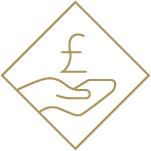LIBERTY & CO.: HISTORY & VALUATIONS
Have you ever wondered what your piece of Liberty & Co. silver is worth?
Find out more about the history of Liberty & Co. and get in touch using the form below for a free valuation.
How we can help you sell your Liberty & Co. silver
Liberty & Co. needs no introduction – in the late 1890s the company occupied most of Regent Street as one of the most prestigious shops in London.
If you own a piece of Liberty & Co. silver, use the enquiry form opposite to request a free valuation of your item. For more information on the history of Liberty & Co. scroll down to the history section at the bottom of the page.
The Market for Liberty & Co. in 2020
The market for Liberty & Co silver is extremely buoyant owing to the reputation of Liberty & Co. and its creator Arthur Lasenby Liberty.
Although Liberty & Co. did not allow designers to inscribe their names on their work, the artists behind the works have since been recognised, and Liberty & Co. silver sells for great prices, with rare pieces commanding a premium.
More than ever condition is key and collectors discriminate against even the smallest imperfection.
Free Valuations Of Your
Liberty & Co. Silver
Receive a free valuation for your Liberty & Co. Silver
Where possible please send us a picture of your piece as this will help speed up the process of giving you a valuation.
Selling your Liberty & Co. silver with Mark Littler Ltd.

Send us details about your silver directly via email or use the form below.

We contact our international network of customers for the best offers.

If you decide to proceed with an offer we issue you with a contract.

Send us your silver. We have a fully insured courier service available.

We complete the sale with the buyer and send your funds via BACS.
Auction or Private Sale?
If you are deciding on how to sell your Liberty & Co. silver we can have a no-obligation chat on the best options for you. We can either make a personal introduction to the best saleroom based on your location and item free of charge. Or we can look into collecting you some no-obligation offers for a private sale, which could save you considerably in commission.
In a nutshell here are the main pros and cons of each option:
- Auctions can provide an increased market exposure (when you choose the right saleroom) but their gross fees can reach as much as 50%, and the payout times can be drawn out.
- Private sales leave you in control of the price, and can be completed quickly but there is no chance of ‘buyers fever’ driving up prices.
Mark Littler Ltd. are one of the only independent advisers in the antique industry. We offer trusted, independent advice to help you sell your Liberty & Co. silver for the highest possible price.
A History of Liberty & Co.
Arthur Lasenby Liberty originally started out selling ornaments and miscellaneous objects from the Far East in a shop in Regent Street in London. The shop was called Liberty & Co. The objects that were sold in the shop – metalwork and teaspoons – were from a mixture of different popular styles. The importation of these goods meant that they required a trademark for sale, which was procured in 1894. By this point, Liberty & Co. was taking up multiple premises on Regent Street, and Arthur Lasenby Liberty was quickly building relationships with British artists affiliated with the Art Nouveau movement. As such, the company quickly became key to the movement’s progress.
Liberty & Co. was one of the most prestigious shops in London, selling ornaments, furniture, and bespoke silks and satins notable for their bright colours and designs. The products at the shop were eclectic and oriental, earning the shop the nickname “East India House”.
Cymric was a range of silverware produced by Liberty & Co., an idea seemingly thought up by Director and Head of the Silk Department, John Llewellyn. Maker’s marks were registered in London and Birmingham in 1899. The range was produced in partnership with Birmingham silversmith W.H. Haseler.
The range was influenced by the Art Nouveau style that Arthur Lasenby Liberty was so supportive of. The silverware was designed specifically as an Art Nouveau interpretation of Celtic style. The pieces were presented as high-quality and original.
The Silver Studio was commissioned to provide the designs that were shown in the exhibition that launched the range. This exhibition was held in Regent Street in May 1899. The Silver Studio was well established at the time, providing material for many manufacturers. Some of the artists that were involved in the production include Rex Silver, Harry Napper, John Illingworth Kay, and principal designer Archibald Knox.
Knox was relatively unknown at the time. However, despite his name not appearing on any of his pieces, the Cymric range made his name a recognisable one. This was due to the originality of his designs. His Celtic Revival style soon became synonymous with Liberty & Co., and today Archibald Knox is recognised as being one of the most influential designers in the industry at the time.
In October 1899, Liberty & Co. held another exhibition showing pieces of silver designed by artists such as Oliver Barker, Bernard Cuzner, and Albert Edward Jones, all based in Birmingham. Oliver Barker’s work was shown to John Llewellyn in the late 1890s, with Llewellyn subsequently deciding that this designer’s work must be in the collection.
In the 1900s catalogue, there are plenty of examples of Arts and Crafts influences on the silverware. These include hand-hammered finishes, and semi-precious stones simply set in silver. Designs by Oliver Baker often included rustic strapwork. Bernard Cuzner’s work was simply but beautifully finished with trees and natural patterns.
The pieces included things such as cigarette boxes, trinkets, spoons, and belt buckles. The designs by Silver Studio are believed to have been handmade in Soho, London. As demand increased, as well as price, production became part-machine, part-hand, with every piece being hand-hammered for finish.
From 1901 onwards, all Liberty Cymric designs were made in Birmingham by William Hair Haseler. All items after this date carry the Birmingham maker’s mark.
Arthur Lasenby Liberty was focused on promoting his brand rather than the individual designers of the silverware. Company policy dictated that all goods had to be marked with “Designed by Liberty & Co.” rather than the name of the designer. These names were only required when the work was displayed by publications.
This has caused some headaches for collectors of Liberty & Co. silver, who are desperate to know who designed particular pieces.
Liberty & Co, silver is highly valued and collectable. The designs are considered to reflect the height of British Art Nouveau and Arts and Crafts, immortalising the influence of both of these movements on British design.
What is your piece of Liberty & Co. silver worth?
Where possible please send us a picture of your piece as this will help speed up the process of giving you a valuation.
Have you ever wondered what your piece of Liberty & Co. silver is worth?
Find out more about the history of Liberty & Co. and get in touch using the form below for a free valuation.
How we can help you sell your Liberty & Co. silver
Liberty & Co. needs no introduction – in the late 1890s the company occupied most of Regent Street as one of the most prestigious shops in London.
If you own a piece of Liberty & Co. silver, use the enquiry form opposite to request a free valuation of your item. For more information on the history of Liberty & Co. scroll down to the history section at the bottom of the page.
Receive a free valuation for your Liberty & Co. Silver
Where possible please send us a picture of your piece as this will help speed up the process of giving you a valuation.
Selling your Liberty & Co. silver with Mark Littler Ltd.

Send us details about your silver directly via email or use the form below.

We contact our international network of customers for the best offers.

If you decide to proceed with an offer we issue you with a contract.

Send us your silver. We have a fully insured courier service available.

We complete the sale with the buyer and send your funds via BACS.
Auction or Private Sale?
If you are deciding on how to sell your Liberty & Co. silver we can have a no-obligation chat on the best options for you. We can either make a personal introduction to the best saleroom based on your location and item free of charge. Or we can look into collecting you some no-obligation offers for a private sale, which could save you considerably in commission.
In a nutshell here are the main pros and cons of each option:
- Auctions can provide an increased market exposure (when you choose the right saleroom) but their gross fees can reach as much as 50%, and the payout times can be drawn out.
- Private sales leave you in control of the price, and can be completed quickly but there is no chance of ‘buyers fever’ driving up prices.
Mark Littler Ltd. are one of the only independent advisers in the antique industry. We offer trusted, independent advice to help you sell your Liberty & Co. silver for the highest possible price.
A History of Liberty & Co.
Arthur Lasenby Liberty originally started out selling ornaments and miscellaneous objects from the Far East in a shop in Regent Street in London. The shop was called Liberty & Co. The objects that were sold in the shop – metalwork and teaspoons – were from a mixture of different popular styles. The importation of these goods meant that they required a trademark for sale, which was procured in 1894. By this point, Liberty & Co. was taking up multiple premises on Regent Street, and Arthur Lasenby Liberty was quickly building relationships with British artists affiliated with the Art Nouveau movement. As such, the company quickly became key to the movement’s progress.
Liberty & Co. was one of the most prestigious shops in London, selling ornaments, furniture, and bespoke silks and satins notable for their bright colours and designs. The products at the shop were eclectic and oriental, earning the shop the nickname “East India House”.
Cymric was a range of silverware produced by Liberty & Co., an idea seemingly thought up by Director and Head of the Silk Department, John Llewellyn. Maker’s marks were registered in London and Birmingham in 1899. The range was produced in partnership with Birmingham silversmith W.H. Haseler.
The range was influenced by the Art Nouveau style that Arthur Lasenby Liberty was so supportive of. The silverware was designed specifically as an Art Nouveau interpretation of Celtic style. The pieces were presented as high-quality and original.
The Silver Studio was commissioned to provide the designs that were shown in the exhibition that launched the range. This exhibition was held in Regent Street in May 1899. The Silver Studio was well established at the time, providing material for many manufacturers. Some of the artists that were involved in the production include Rex Silver, Harry Napper, John Illingworth Kay, and principal designer Archibald Knox.
Knox was relatively unknown at the time. However, despite his name not appearing on any of his pieces, the Cymric range made his name a recognisable one. This was due to the originality of his designs. His Celtic Revival style soon became synonymous with Liberty & Co., and today Archibald Knox is recognised as being one of the most influential designers in the industry at the time.
In October 1899, Liberty & Co. held another exhibition showing pieces of silver designed by artists such as Oliver Barker, Bernard Cuzner, and Albert Edward Jones, all based in Birmingham. Oliver Barker’s work was shown to John Llewellyn in the late 1890s, with Llewellyn subsequently deciding that this designer’s work must be in the collection.
In the 1900s catalogue, there are plenty of examples of Arts and Crafts influences on the silverware. These include hand-hammered finishes, and semi-precious stones simply set in silver. Designs by Oliver Baker often included rustic strapwork. Bernard Cuzner’s work was simply but beautifully finished with trees and natural patterns.
The pieces included things such as cigarette boxes, trinkets, spoons, and belt buckles. The designs by Silver Studio are believed to have been handmade in Soho, London. As demand increased, as well as price, production became part-machine, part-hand, with every piece being hand-hammered for finish.
From 1901 onwards, all Liberty Cymric designs were made in Birmingham by William Hair Haseler. All items after this date carry the Birmingham maker’s mark.
Arthur Lasenby Liberty was focused on promoting his brand rather than the individual designers of the silverware. Company policy dictated that all goods had to be marked with “Designed by Liberty & Co.” rather than the name of the designer. These names were only required when the work was displayed by publications.
This has caused some headaches for collectors of Liberty & Co. silver, who are desperate to know who designed particular pieces.
Liberty & Co, silver is highly valued and collectable. The designs are considered to reflect the height of British Art Nouveau and Arts and Crafts, immortalising the influence of both of these movements on British design.
Receive a free valuation for your Liberty & Co. Silver
Where possible please send us a picture of your piece as this will help speed up the process of giving you a valuation.
